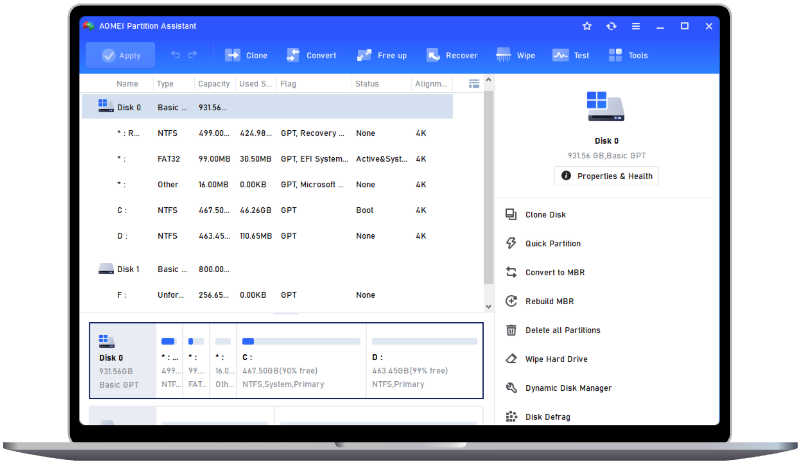PC Not Recognizing an Ejected USB? Fix It Now!
If your PC is not recognizing a USB after it has been ejected, you're not alone. In this guide, we’ll walk you through step-by-step solutions to resolve the problem and get your device recognized and functioning again.
Why is your PC not recognizing an ejected USB?
USB devices are widely used for data storage and transfer across different devices. Normally, you can plug in a USB drive to access your files, but sometimes, your computer may fail to recognize it. Even after ejecting and reconnecting the USB, it may not appear in File Explorer. Why does this happen? Here are some common reasons:
👉 USB drivers may become outdated or corrupted over time.
👉 The USB Selective Suspend feature in Windows prevents the device from being recognized when reconnected.
👉 There are some file system errors on your USB.
👉 The USB device itself may be physically damaged.
👉 The USB device is infected by viruses.
5 Ways to Fix "PC Not Recognizing an Ejected USB"
Computers not recognizing USB devices can be frustrating, especially when essential data is stored on them. Fortunately, there are several ways to troubleshoot and fix this issue. If you are experiencing the same issue, follow these steps carefully to get your USB device working again.
Method 1: Restart Your PC and Reconnect the USB
Sometimes, the simplest solutions are the most effective. If your computer is not recognizing the USB, start by restarting your PC and reconnect the USB:
Step 1: Safely eject the USB device if it’s still connected and unplug the USB device from the current port.
Step 2: Restart your computer and reconnect the USB device to your PC.
Step 3: Check if the USB device is recognized. If not, move on to the next method.
Method 2: Update or Reinstall USB Drivers
Outdated or corrupted drivers are another common cause of a PC not recognizing the ejected USB. Follow these steps to update or reinstall the drivers manually:
Step 1: Press Windows + X and select Device Manager.
Step 2: Expand the Universal Serial Bus controllers section.
Step 3: Right-click on the USB device and select Properties > Driver > Update Driver.
Step 4: Then, choose Search automatically for updated driver software and follow the on-screen instructions to install it.
Step 5: After reinstalling, restart your PC and connect the USB drive to see if it can be recognized.
Method 3: Disable USB Selective Suspend
The USB Selective Suspend feature can sometimes turn off USB ports to save power, which may prevent the device from being recognized when reconnected. You can follow these steps to disable this feature.
Step 1: Type power plan in the search box and then select Choose a power plan.
Step 2: Click Change plan settings next to your currently selected plan.
Step 3: Select Change advanced power settings.
Step 4: Expand the drop-down menu next to Plugged in and then choose the Disabled option.
Step 5: Click Apply > OK to save changes.
Method 4: Check the Disk Errors
Sometimes, eject USB not showing up after reconnecting occurs due to file system errors on the device. You can run CHKDSK to detect and fix these issues.
Step 1: Type cmd in the search box and select Run as administrator.
Step 2: In the pop-up window, type chkdsk g: /f /r /x (Replace g with the drive letter of your USB drive.) and press Enter. This will both detect and repair disk errors.
Step 3: Wait until the whole disk check process finishes. Then, restart your computer to see if it can recognize the USB.
Method 5: Format the USB
If none of the above methods work, consider formatting the USB drive directly. Whether your USB device is infected by viruses or experiencing file system errors, formatting can help restore its functionality and prepare it for reuse.
One of the most reliable tools for this task is AOMEI Partition Assistant, a professional and versatile disk management tool that simplifies the formatting process. It supports multiple file systems, including NTFS, FAT32, exFAT, Ext2, Ext3, and Ext4, making it suitable for a wide range of use cases, from Windows storage to Linux compatibility.
Let’s use AOMEI Partition Assistant to reformat the USB devices:
Step 1: Install and launch the software; then, right-click on the USB device and select Format Partition.
Step 2: In the pop-up window, choose a file system as needed and click OK.
Step 3: Click Apply and Proceed to start the formatting process.
Step 4: Once formatting is complete, reconnect the USB device to see if it’s recognized.
Additional Tips for Using USB Devices
✔ Always eject safely: Use the "Safely Remove Hardware" option before unplugging your USB device. This ensures all data is properly written and helps prevent file corruption.
✔ Back up your data: Create a copy of important files on another storage device or cloud service in case of unexpected errors or device failures.
✔ Be cautious when plugging: If the USB doesn’t plug in easily, don’t force it. Double-check the orientation and try again to avoid damaging the port or the device.
✔ Protect from physical damage: Avoid dropping your USB drive or exposing it to extreme temperatures, moisture, or other conditions that could cause physical harm.
To Sum Up
Dealing with a PC not recognizing an ejected USB can be frustrating, but it’s often resolvable with the right steps. This post provides five effective methods to resolve this issue and get your USB device recognized again. For persistent issues, it is advised to format the USB with AOMEI Partition Assistant as a final step.
Additionally, the software includes advanced disk management features such as resizing partition, cloning USB drives, and enabling BitLocker for USB, making it a comprehensive solution for managing USB and other storage devices.
FAQs
Q1: Can a damaged USB device cause recognition issues?
Yes, a damaged USB device can prevent your computer from detecting it. If the USB is severely damaged and not detected on any device, it may be beyond repair.
Q2: How do I check if my USB drive is faulty?
You can test the USB on another computer. If it’s not recognized there, the drive may be damaged. Alternatively, use disk management tools to see if the drive appears but isn’t assigned a letter.
Q3: Is it safe to format a USB device?
Yes, formatting is safe but it will erase all data on the USB. Make sure to back up important files before proceeding.


